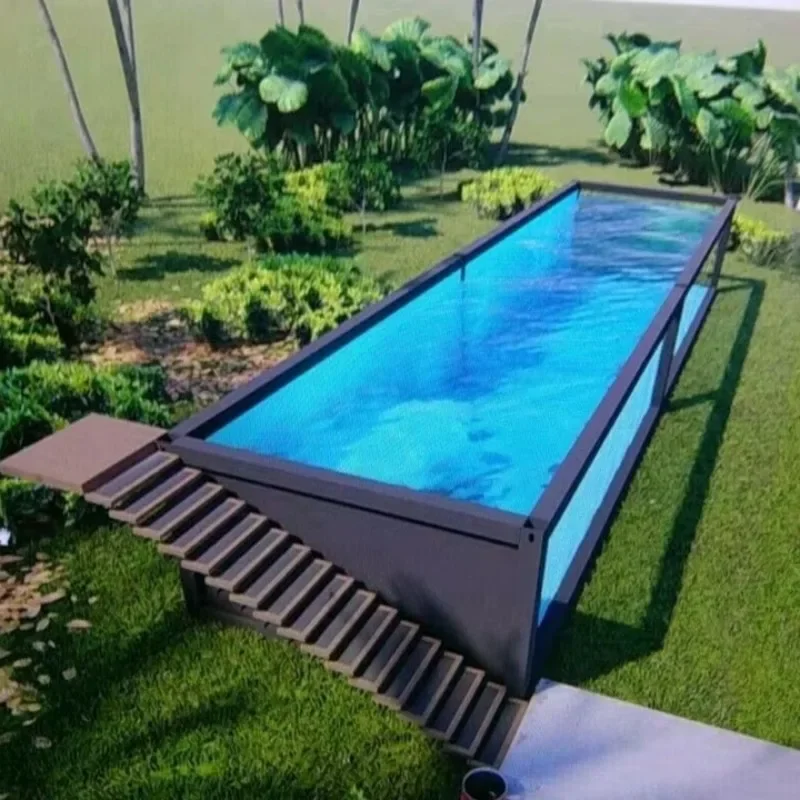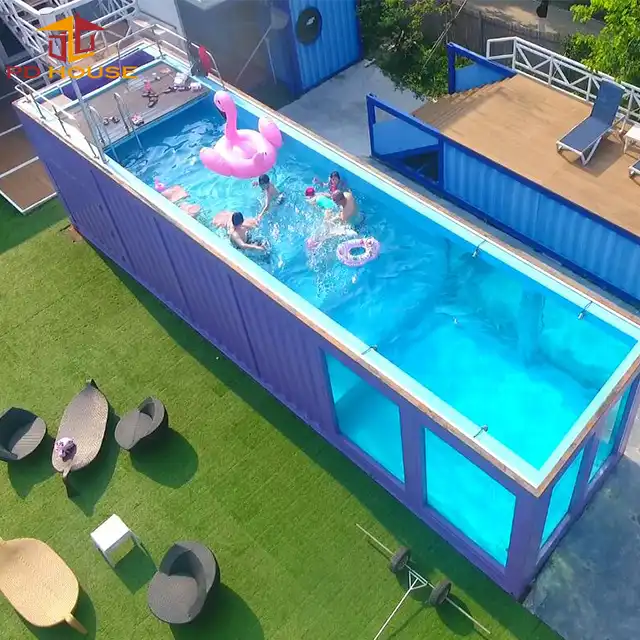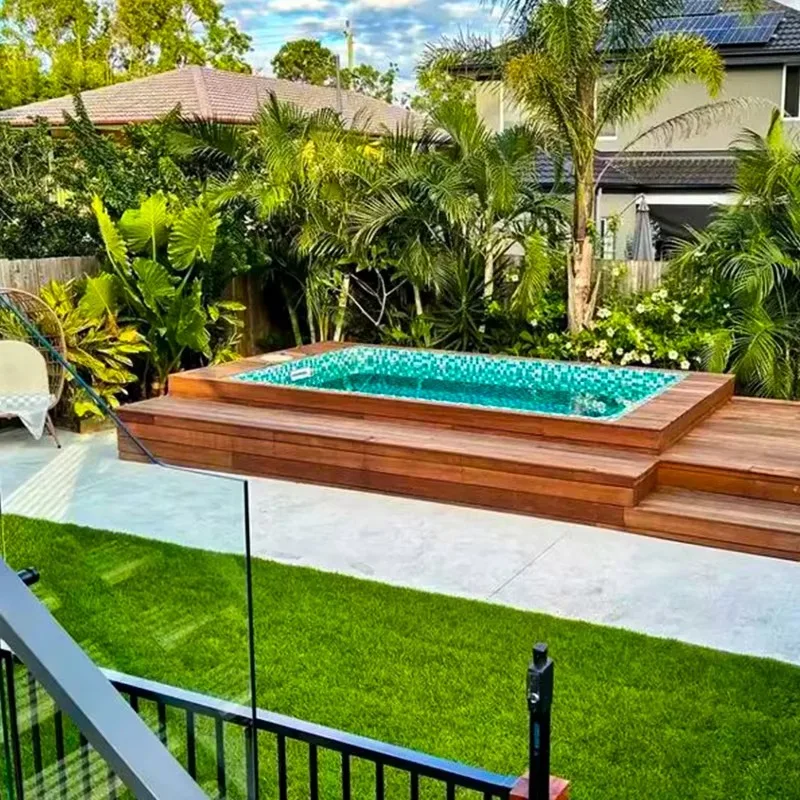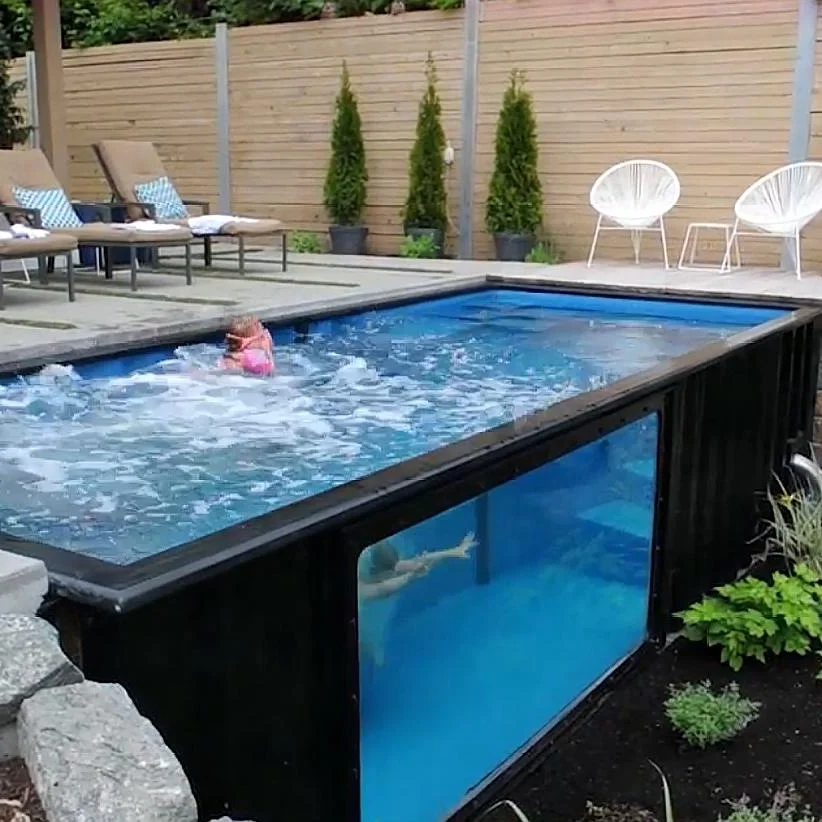A shipping container swimming pool is revolutionizing outdoor living spaces across the globe. This innovative concept turns retired cargo containers into stylish, durable, and eco-friendly swimming pools. As urban spaces shrink and homeowners seek unique alternatives to traditional in-ground pools, more people are turning to this modern solution. Not only do these structures offer cost-effective installation, but they also provide flexibility in design and placement. Whether you’re building a compact dip pool for a city rooftop or a full-sized lap pool in your garden, a shipping container swimming pool fits nearly any need. Moreover, because they’re made from recycled steel, they support sustainable construction practices. In this article, we’ll explore why so many homeowners are making the switch, how to plan your own project, and what makes this trend both practical and visually striking.
 Why Choose a Container Swimming Pool?
Why Choose a Container Swimming Pool?
There are countless reasons to consider a shipping container swimming pool for your property. First and foremost, they are significantly faster to install than traditional pools. While digging, plumbing, and curing concrete can take weeks, a container pool often requires only days of setup after delivery. Additionally, their modular nature allows for easy relocation if needed. Since they come in standard sizes—typically 20 or 40 feet—you can plan your layout with precision. Furthermore, shipping container swimming pools are structurally sound. These containers were originally built to withstand ocean voyages and heavy stacking, meaning they’re tough enough to handle soil pressure and water weight.
Another major advantage is customization. You can modify the interior with tiles, fiberglass lining, or epoxy coatings. Windows, steps, and lighting can all be added during the build process. Also, because the shell is already watertight once properly sealed, there’s less risk of leaks over time. Many people also appreciate the industrial-chic aesthetic that blends well with modern architecture. Ultimately, choosing this option means embracing innovation, durability, and design freedom—all while reducing environmental impact through reuse.
Design Flexibility and Creative Possibilities
One of the most exciting aspects of a shipping container swimming pool is its potential for creative expression. Unlike conventional pools that follow rigid shapes, container pools can be stacked, angled, or combined to form dynamic layouts. For example, two 20-foot units can be joined side by side to create a wider swimming area. Alternatively, vertical stacking allows for multi-level installations, such as a plunge pool above a storage room or changing area below. Architects have even used them to build infinity edges on hillsides, offering breathtaking views.
Moreover, finishes play a big role in personalization. Homeowners can choose stainless steel interiors for a sleek look or apply mosaic tiles for a luxurious feel. LED lighting strips enhance ambiance at night, while wooden decking around the rim adds warmth. Some designs incorporate green roofs on top of buried containers, blending the structure into the landscape. Others include retractable covers or glass enclosures for year-round use.
In addition, landscaping complements the overall effect. Tropical plants, stone pathways, and ambient lighting help integrate the pool into its surroundings. Because these pools don’t require massive excavation, they work well in tight urban yards or sloped terrain. Overall, the possibilities are limited only by imagination and local regulations.
 Installation Process: What to Expect
Installation Process: What to Expect
Setting up a shipping container swimming pool involves several clear steps. First, you must select a suitable site. It should be level, well-drained, and accessible for truck delivery. Next, prepare the foundation. Options include gravel beds, concrete slabs, or adjustable piers, depending on ground conditions. Proper support prevents shifting and ensures long-term stability.
Then, the container is delivered and positioned using a crane or forklift. After placement, modifications begin. Workers cut openings for stairs, ladders, or windows. They also reinforce corners and seams to handle hydrostatic pressure. Waterproofing follows—common methods include spray-on liners, fiberglass coating, or vinyl wraps. Each method has pros and cons, so consult professionals before deciding.
Plumbing and filtration systems are installed next. Pumps, filters, heaters, and chlorinators connect just like in regular pools. Electrical wiring must meet safety codes, especially near water. Finally, finishing touches complete the project. These might include tiling, decking, lighting, and fencing. Throughout the process, inspections ensure compliance with local regulations. With careful planning, most installations finish within one to three weeks.
Environmental Benefits of Reusing Containers
Choosing a shipping container swimming pool supports sustainability in meaningful ways. Every year, millions of shipping containers become obsolete after international transport. Many end up scrapped or abandoned, contributing to metal waste. By repurposing them, we reduce landfill burden and conserve raw materials. Recycling one container saves approximately 3,500 kilograms of steel from being melted down.
In addition, manufacturing new pools consumes large amounts of energy and resources. Concrete production alone emits significant CO₂. Container pools bypass much of this impact since the main structure already exists. Their compact size also means less water usage compared to larger traditional pools. On average, a 20-foot container holds about 12,000 to 15,000 liters—roughly half the volume of a standard in-ground pool.
Furthermore, many builders pair these pools with eco-technologies. Solar-powered heaters, saltwater sanitizers, and rainwater collection systems enhance environmental performance. Some owners install green roofs or native plants nearby to promote biodiversity. Even transportation emissions are minimized when sourcing containers locally. Altogether, this approach aligns with green building principles and responsible consumption.
Overcoming Common Challenges and Misconceptions
Despite growing popularity, some concerns still surround shipping container swimming pools. One frequent worry is rust and corrosion. However, modern containers are made from Corten steel, which forms a protective oxide layer. When properly maintained and sealed, they resist degradation for decades. Applying anti-corrosive paint and ensuring good drainage further extend lifespan.
Another misconception is structural weakness. Critics argue that containers aren’t designed to hold water. Yet, with internal bracing and correct anchoring, they safely contain thousands of liters under pressure. Engineers often add cross-beams or external frames for extra support. Proper waterproofing eliminates leakage risks.
Permitting issues can arise in certain areas. Local zoning laws may restrict non-traditional pools or require specific safety measures. Always check regulations before starting construction. Noise during delivery and installation is temporary but worth noting. Lastly, insulation matters in colder climates. Adding foam panels or burying part of the container helps retain heat. Addressing these factors early leads to smoother projects and lasting enjoyment.
 Real-Life Examples Around the World
Real-Life Examples Around the World
Around the globe, inspiring examples showcase the versatility of shipping container swimming pools. In Australia, a coastal home features a 40-foot container pool with floor-to-ceiling glass sides, merging sea views with backyard luxury. Meanwhile, in Amsterdam, an urban rooftop uses two stacked containers—one as a lounge space below and a shallow dipping pool above.
In California, a minimalist design embeds a container flush with the patio, creating a seamless indoor-outdoor flow. The surrounding redwood deck and boulders make it appear natural. Another project in South Africa combines three containers in an L-shape, forming a social swimming zone with built-in seating. Solar heating keeps it warm year-round.
Even commercial spaces adopt this trend. Eco-resorts in Thailand use container pools as guest amenities, reducing construction time and environmental disruption. Similarly, fitness centers in London install narrow container lap pools for interval training. Each case demonstrates adaptability across climates, budgets, and purposes. These real-world applications prove that functionality doesn’t compromise beauty.
H3: How to Maintain Your Container Pool Year-Round
Maintaining a shipping container swimming pool is straightforward with routine care. First, test water chemistry weekly. Balance pH, chlorine, and alkalinity levels to prevent algae and irritation. Use a reliable testing kit or digital meter for accuracy. Second, clean the surface regularly. Skim debris daily and scrub walls monthly to stop buildup.
Filter systems need consistent attention. Backwash sand filters every few weeks. Replace cartridge filters as recommended. Inspect pump seals and hoses annually for wear. In colder regions, winterizing is crucial. Drain water below the frost line or use antifreeze solutions. Cover the pool securely to keep out leaves and snow.
Inspect the container itself twice a year. Look for scratches, dents, or signs of rust. Touch up paint where needed. Check anchor points and foundation stability, especially after heavy rains. If insulated, verify that foam layers remain intact. Trim nearby trees to avoid falling branches. With simple habits, your shipping container swimming pool will stay safe, clean, and beautiful for years.
 Frequently Asked Questions (FAQ)
Frequently Asked Questions (FAQ)
Can I install a shipping container swimming pool myself?
Yes, experienced DIYers can manage basic setups. However, tasks like cutting steel, welding, and electrical work require professional help. Always hire licensed plumbers and electricians for critical components.
How long does a container pool last?
With proper maintenance, it can last 20 to 30 years. Corrosion protection and timely repairs are key. Using high-quality liners extends usability.
Do I need planning permission?
It depends on your location. Some municipalities treat container pools like permanent structures. Check local building codes before starting.
Are container pools safe for children?
They are as safe as any pool when supervised. Install fences, alarms, or covers to meet safety standards.
Can I heat my container pool?
Absolutely. Solar heaters, electric heaters, or heat pumps work well. Insulation improves efficiency.
What size options are available?
Most use 20-foot or 40-foot containers. Custom lengths are rare but possible through fabrication.
Is condensation a problem?
Only in enclosed or indoor models. Ventilation and dehumidifiers solve moisture buildup.
Can I bury a container pool?
Yes, partially or fully. But reinforce walls to resist soil pressure. Waterproof thoroughly before backfilling.
 Final Thoughts on Modern Backyard Innovation
Final Thoughts on Modern Backyard Innovation
The rise of the shipping container swimming pool reflects a shift toward smarter, greener living. No longer confined to industrial zones, these rugged steel boxes now serve as elegant backyard retreats. They combine affordability, speed of installation, and design freedom in ways traditional pools cannot match. At the same time, they honor sustainability by giving old materials new life. As technology improves and awareness grows, more people will discover their potential. Whether you want a sleek urban oasis or a rustic countryside escape, this solution adapts beautifully. Importantly, understanding local rules, choosing quality materials, and working with experts ensures success. Ultimately, investing in a shipping container swimming pool isn’t just about adding a place to swim—it’s about embracing innovation with purpose.